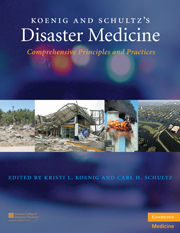Book contents
- Frontmatter
- Contents
- List of Contributors
- Contributor Biographies
- Foreword
- Preface
- Acknowledgments
- PART I CONCEPTUAL FRAMEWORK AND STRATEGIC OVERVIEW
- PART II OPERATIONAL ISSUES
- 9 Public Health and Emergency Management Systems
- 10 Legislative Authorities and Regulatory Issues
- 11 Syndromic Surveillance
- 12 Triage
- 13 Personal Protective Equipment
- 14 Decontamination
- 15 Quarantine
- 16 Mass Dispensing of Antibiotics and Vaccines
- 17 Management of Mass Gatherings
- 18 Transportation Disasters
- 19 Emergency Medical Services Scene Management
- 20 Healthcare Facility Disaster Management
- 21 Mass Fatality Management
- 22 Crisis and Emergency Risk Communication
- 23 Telemedicine and Telehealth Role in Public Health Emergencies
- 24 Complex Public Health Emergencies
- 25 Patient Identification and Tracking
- PART III CLINICAL MANAGEMENT
- Index
- Plate section
- References
22 - Crisis and Emergency Risk Communication
from PART II - OPERATIONAL ISSUES
Published online by Cambridge University Press: 05 August 2011
- Frontmatter
- Contents
- List of Contributors
- Contributor Biographies
- Foreword
- Preface
- Acknowledgments
- PART I CONCEPTUAL FRAMEWORK AND STRATEGIC OVERVIEW
- PART II OPERATIONAL ISSUES
- 9 Public Health and Emergency Management Systems
- 10 Legislative Authorities and Regulatory Issues
- 11 Syndromic Surveillance
- 12 Triage
- 13 Personal Protective Equipment
- 14 Decontamination
- 15 Quarantine
- 16 Mass Dispensing of Antibiotics and Vaccines
- 17 Management of Mass Gatherings
- 18 Transportation Disasters
- 19 Emergency Medical Services Scene Management
- 20 Healthcare Facility Disaster Management
- 21 Mass Fatality Management
- 22 Crisis and Emergency Risk Communication
- 23 Telemedicine and Telehealth Role in Public Health Emergencies
- 24 Complex Public Health Emergencies
- 25 Patient Identification and Tracking
- PART III CLINICAL MANAGEMENT
- Index
- Plate section
- References
Summary
OVERVIEW
Crisis and Emergency Risk Communication (CERC) is a recognized field of study that differs from health risk and risk communication. It is used in disasters and combines elements of the other types of risk communication, but has emerged as a new field recognized by academia. At the time of this writing, CERC is taught in 22 universities in the United States and is being diffused internationally. In addition, the Pan American Health Organization, World Health Organization, and North Atlantic Treaty Organization have adopted CERC principles for their communication work. Hence, CERC is the risk communication term that will be used in this chapter.
A CASE FOR EMERGENCY, CRISIS AND HEALTH RISK COMMUNICATION
Health risk communications are an important and necessary component of disaster management. Although a population or community faced with a PICE (potential injury/illness creating event) will not overcome its challenges solely through the application of appropriate communication principles, an organization can compound its problems during an emergency if it has neglected sound CERC planning. Failure to “be first,” “be right,” and “be credible” and deliver empathetic messages may interfere with what would otherwise be well-planned and executed response operations. Integrating CERC into the planning and early stages of disaster response will improve operations and speed recovery.
Keywords
- Type
- Chapter
- Information
- Koenig and Schultz's Disaster MedicineComprehensive Principles and Practices, pp. 326 - 344Publisher: Cambridge University PressPrint publication year: 2009



